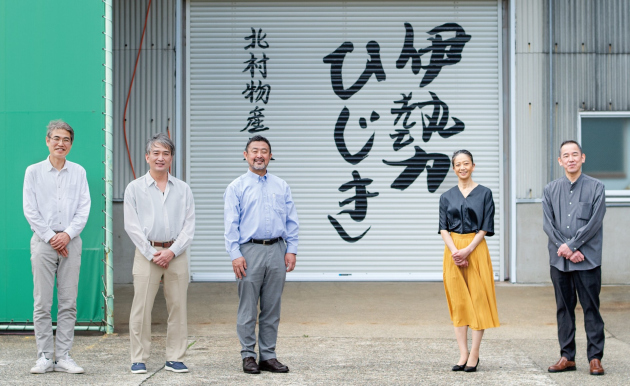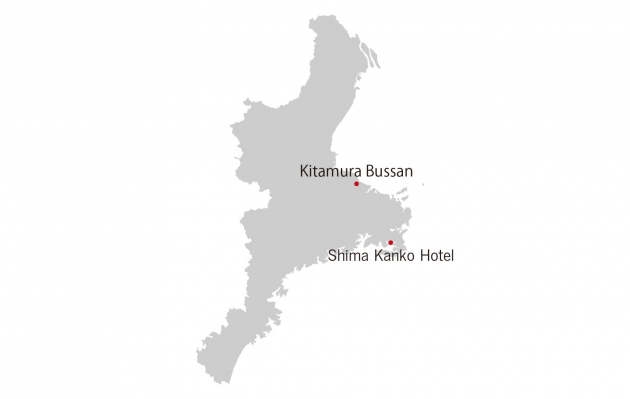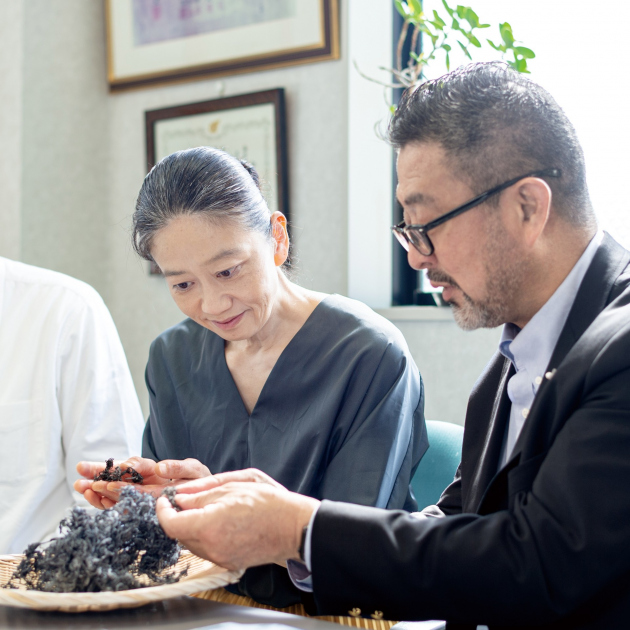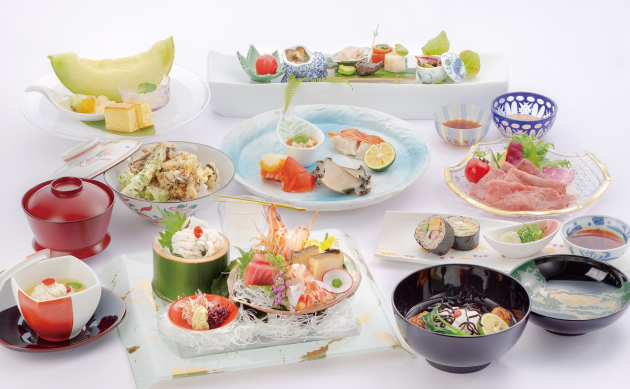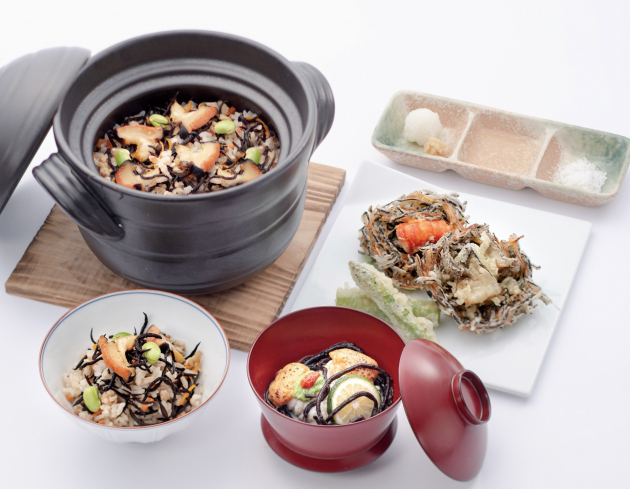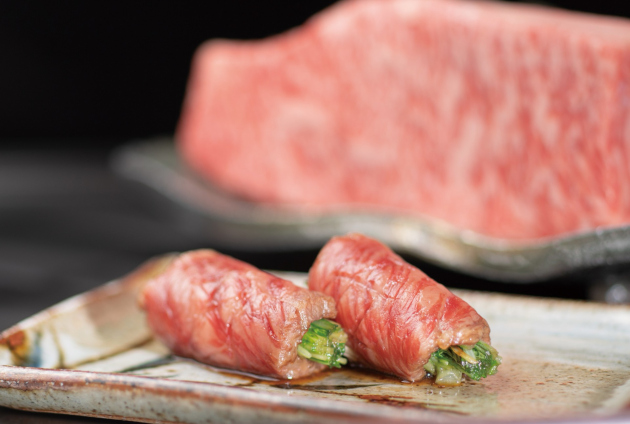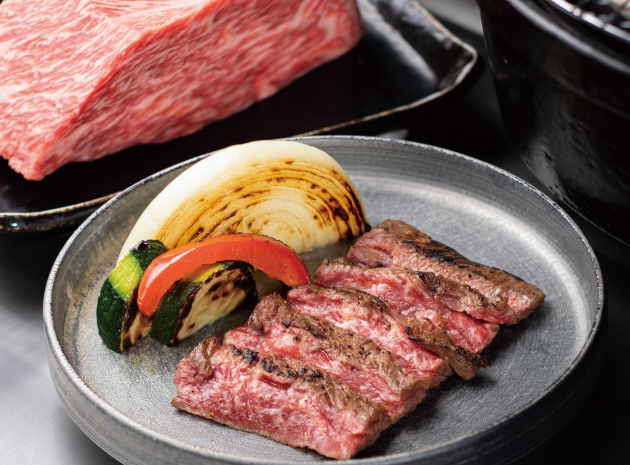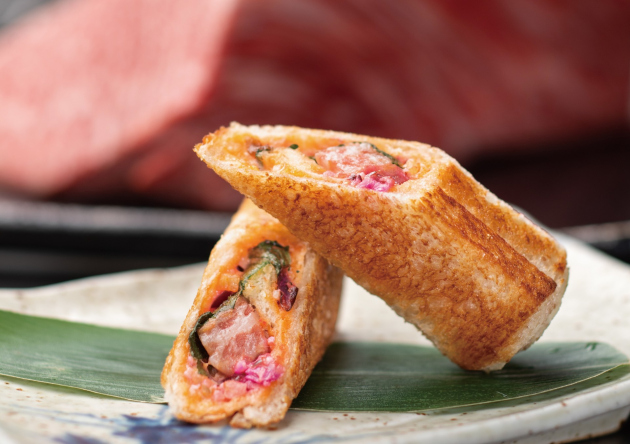Ise Hijiki
Shima Kanko Hotel’s seasonal magazine "Shima Time" introduces the four seasons of Ise-Shima through the local culture, rich nature, and food.
The Home of Ise Hijiki
From Shima Time Summer 2023 Issue
The home of Ise hijiki seaweed—a delicacy refined by the blessings of water, climate, and topography
Ise hijiki edible seaweed, produced in the Ise-Shima region, is among the most recognized produce of Mie Prefecture. It has a long history, with a wooden tablet from Heijo-kyo, Japan’s ancient capital, attesting that seaweed from Ise-Shima, including hijiki, was presented to the Imperial Court there.
The hijiki harvested in Toba and Shima grows in the high-quality fishing grounds of Ise Bay, into which rich mountain nutrients flow from the three rivers of Kiso and other rivers in Mie.
We visited Kitamura Bussan, a company founded during Japan’s Kansei era (approximately 200 years ago) that processes Ise hijiki seaweed, and learned about the history of Ise hijiki and their dedication to it.

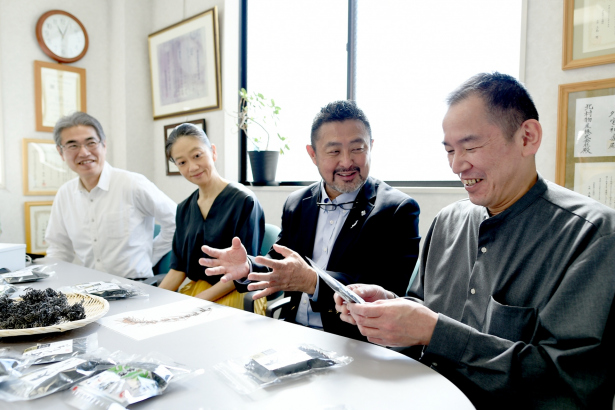
"It's the characteristics and climatic conditions of this area. Here, we can secure the large quantities of fresh water necessary for processing hijiki. In the past, hijiki was dried in the sun. Annual rainfall is low here, which also contributes to processing high-quality Ise hijiki." About 300 meters east of the Kitamura Bussan factory lies Ise Bay, with its gentle waves. Before the overland route was established, marine routes to Mikawa and Edo made this location ideally suited to producing and shipping hijiki.
"Ise hijiki is produced using the distinctive method of steaming without boiling. This traditional processing method ensures the hijiki does not get watery, so that strong hijiki flavor remains. It takes a lot of time and effort, but this is how we’ve done it for countless years."
The customs of a historic fishing village are where the delicious flavor starts.
Japanese Cuisine Executive Chef Tsukahara says, "In Japanese cuisine, long hijiki is often used as an ingredient for good fortune. Softer bud hijiki is also delicious in simmered dishes and hijiki rice dishes."
Kitamura says, "We’re dedicated to making hijiki that is long, thick, firm, and flavorful. You can enjoy the firm texture and ocean aroma, and its strong flavor makes it a great match for dishes seasoned with vinegar too," he says, energetically.
Next, we observed the processing of hijiki seaweed. The hijiki is piled up in bags marked with its place of origin prior to processing.
"In Ise-Shima, hijiki is harvested on high tide days from April to May, whenever the tide is out. We make sure to check the condition of the hijiki in our production areas every year."
Fishermen and divers harvest the hijiki and dry it in the sun. The highest quality hijiki is then selected and purchased. At the processing plant, salt is first washed off the hijiki.
"Hijiki is delicate, and its condition varies depending on region and year. Artisans determine how long to steam the hijiki based on the feel of their own hands when washing the hijiki. Long years of experience are the most important factor in achieving the ideal Ise hijiki."
Finally, Kitamura shared one more reason for the delicious flavor of Ise hijiki.
"Perhaps because the fishermen of Ise-Shima have a tradition of harvesting high-quality seaweed for the Imperial Court, they gather hijiki while it is still young and delicious. Since it hasn’t grown excessively, it has no air nodules, which improves the texture.
As processors, I believe we owe a debt of gratitude to these fishermen for helping us make great products.We have been involved with the fishing village of Ise-Shima for many years, and we want our customers to take an interest in the production area through Ise hijiki."
Executive Chef Higuchi explains, "The reason why Ise hijiki is so delicious is not only the quality of the ingredients, but also the skill and love of the processors, cultivated over many years, who know the characteristics of hijiki inside out. I believe we must continue to develop dishes that take advantage of the greatness of this ingredient, as well as the processing techniques."
Summer Dish Delivered by Executive Chef - Hiroe Higuchi's Cooking Story
Ise Hijiki Salad and Galette
Ise hijiki, with its sticky texture and rich flavor of the sea, is the main ingredient in this dish.
The image I had in mind was a hijiki salad. We sauté aromatic vegetables in olive oil flavored with garlic, add blanched long hijiki, honey, balsamic vinegar, white wine vinegar, and citrus juice, and simmer. Then we add cooked glutinous barley and let the flavors blend. The hijiki soaks up the sour and sweet flavors, giving it a refreshing taste perfect for summer.
It is planned to be included in the "Degustation" course from June to August.
*Period of availability may change depending on shipment conditions.
| French Restaurant "La Mer" | The Bay Suites 5F Dinner 17:30 - 21:00 (L.O. 19:30) *Some changes are currently in effect for our business hours |
|---|
Summer Miketsukuni Kaiseki
This summer menu features seasonal ingredients such as abalone and pike conger, as well as Ise hijiki seaweed.
The abalone is grilled and served with two different flavors: a soy sauce with pureed abalone liver and a savory butter soy sauce. To create the sashimi, abalone is sandwiched between sheets of kelp and heated at low temperature to soak up the flavor, drawing out the aroma of the sea and improving the texture.
Pike conger is served in a fluffy chawanmushi (steamed egg custard), with the meaty flesh presented as scalded sashimi. Kuzuuchi, which has a smooth texture, is made into a soup together with long hijiki, said to bring good fortune. Ise hijiki has a unique texture and an aroma of the sea.
Buckwheat sushi rolled with prawn and conger eel as a palate cleanser.
The chef's top recommendation is also available as a chilled summer dish. Enjoy with your favorite ingredients such as scalded Matsusaka beef thigh, steamed abalone, and grilled spiny Ise lobster.
Summer Miketsukuni Kaiseki
June 1st (Thu.) - August 31st (Thu.)
¥33,500
Delicious Ise Hijiki Assortment
Hijiki is a much-loved ingredient in Japanese cuisine, and its ocean aroma pairs well with dashi broth. We have prepared Ise hijiki in a variety of ways for you to enjoy.
Combined with seasonal turban shells, bud hijiki is cooked in an earthenware pot with rice. This dish is incredibly fragrant, with the aroma of the sea.
A luxurious fried tempura is also made by combining bud hijiki with abalone and spiny Ise lobster.
Grilled sea urchin and pike conger soup pair well with long hijiki.
We hope you enjoy the robust texture and flavor.
These dishes are available as part of the special "Takumi" kaiseki course (rice cooked in an earthenware pot) and the Summer Miketsukuni kaiseki course (soup and fried tempura) from June through August.
| Japanese Restaurant "Hamayu" | The Baysuites 4F Dinner 17:30 - 21:00 (L.O. 19:30) Lunch 11:30 - 13:30 (L.O. 13:00/ until 20:00 2 days before) *Some changes are currently in effect for our business hours *Lunch is available for a minimum of 4 people. |
|---|
Garlic rice with Ise hijiki, made with renowned Musubi-no-Kami rice from Mie Prefecture
A garlic rice dish served with soft, delicious bud hijiki.
Rehydrated bud hijiki simmered with Matsusaka beef tendons to imbue it with flavor and aroma. Hijiki mixes well with rice for a pleasing texture. Musubi-no-Kami rice from Mie Prefecture, the firm texture of hijiki, and the flavor of Matsusaka beef. All the unique flavors of Ise-Shima served as teppanyaki.
From June to August, enjoy a pairing dinner of fantastic Mie produce with summer flavors.
Summer Dish Delivered by Head Chef of Teppanyaki Yamabuki — Masaya Kurino's Cooking Story
This summer pairing dinner features different cuts of Matsusaka beef cooked to bring out their individual characteristics.
The sirloin is thinly sliced, quickly seared teppanyaki-style, wrapped around mizuna greens, and served as a sukiyaki-style dish with homemade warishita broth seasoned with sansho pepper.
Teppanyaki-grilled fillet has a tender texture and refined flavor, and is served with wasabi. Bavette (flap steak), a rarely seen cut, is characterized by its fine-grained, dense texture. It is smoked over a slow fire, releasing more delicious fat and aroma the more you chew.
An aitchbone cut, boasting a good amount of fat on lean meat, is grilled teppanyaki-style and rolled in bread with shiso leaves and shibazuke pickles. Its tartness and refreshing aroma pairs perfectly with the delicious flavor of Matsusaka beef, leaving lingering flavor.
From June to August, enjoy a pairing dinner of fantastic Mie produce with summer flavors.
¥67,000 for two people
| Teppanyaki Restaurant Yamabuki | The Club 2F (reservation required) Lunch (weekends only) 11:30 - 13:30 (LO13:00 / Book by 20:00 2 days in advance) Dinner 17:30 - 21:00 (L.O. 19:30/ Book by 20:00 1 day in advance) *Some changes are currently in effect for our business hours *Lunch is available for a minimum of 4 people. |
|---|
Back to a list of feature stories
Shima Kanko Hotel’s Seasonal Magazine "Shima Time"
Alongside these changing seasons, the seasonal magazine "Shima Time" introduces the four seasons of Ise-Shima through the local culture, rich nature, and more.

